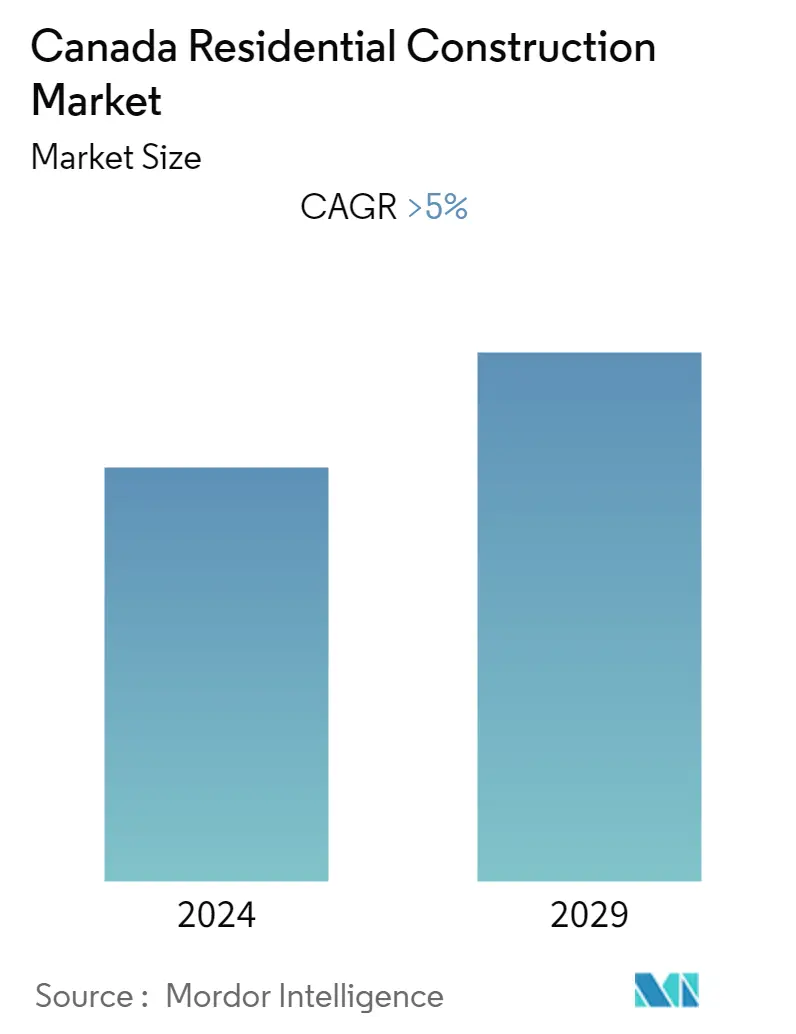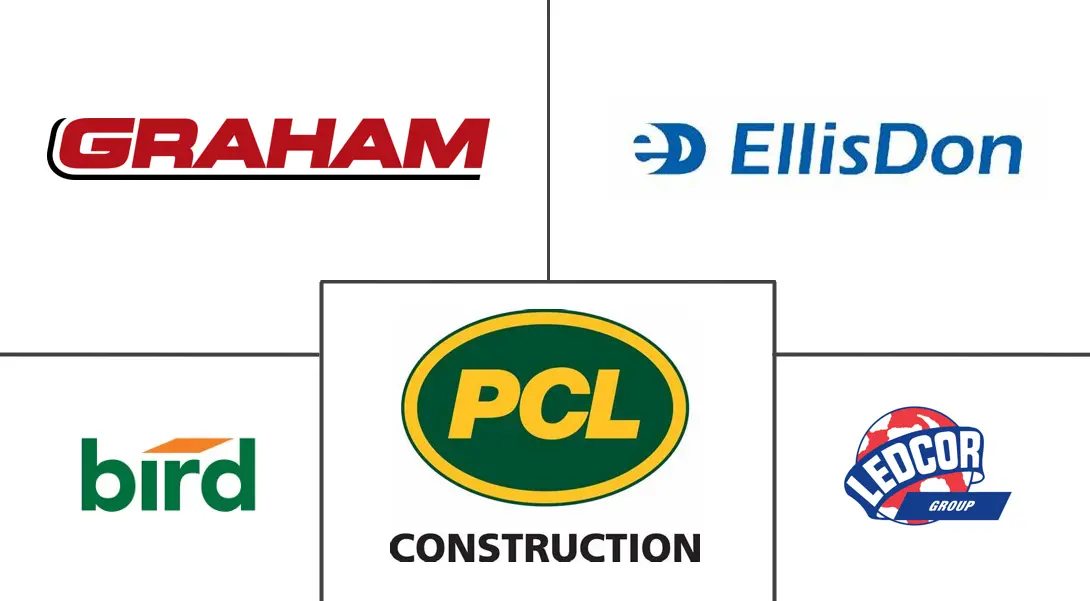Market Size of Canada Residential Construction Industry

| Study Period | 2020 - 2029 |
| Base Year For Estimation | 2023 |
| Forecast Data Period | 2024 - 2029 |
| Historical Data Period | 2020 - 2022 |
| CAGR | > 5.00 % |
| Market Concentration | Low |
Major Players
*Disclaimer: Major Players sorted in no particular order |
Canada Residential Construction Market Analysis
The Canada residential construction market is estimated to register a CAGR of greater than 5% during the forecast period.
- The construction industry was deemed essential and operations were able to continue through government-imposed restrictions and lockdowns. Nonetheless, weak economic activity and uncertainty weighed heavily on the sector. However, despite the slowdown during the initial months of the COVID-19 pandemic, challenging lumber and product material prices, and shortages, the residential construction industry was a key driver in Canada's economy in 2020.
- In the first half of 2022, housing starts were mixed across Canada's largest urban centers. Rental construction was generally resilient, due to strong demand for this type of housing, while developers took a more cautious approach to start new condominium apartment projects, due to the higher interest-rate environment.
- Increases in construction costs and materials shortages were also felt across markets, impacting construction times and the affordability of the housing delivered. After a boom recorded in 2021, housing starts in the country's six largest census metropolitan areas (CMAs) fell 5% in the first half of 2022. The decrease in apartment construction (-9%) is the main cause of this drop. On an annualized basis, however, housing starts in the first half of 2022 remained high compared to the level of construction over the past five years.
- In the Vancouver CMA, housing starts declined by about 25% in the first half of 2022. This slowdown was mainly due to a decrease in the number of condominium apartments started, owing to the greater number of rental apartments started. Vancouver's low vacancy rate, in a more uncertain economic environment for buyers, led residential property developers to turn to the rental segment.
- After hitting historic levels in 2021, apartment starts also declined. Toronto had the largest number of housing starts in the first half of 2022 (19,520, up 7%). While the construction of apartments and row houses increased in Toronto, the construction of generally less affordable housing types (single-detached and semi-detached houses) decreased. In Ottawa, housing starts declined for almost all dwelling types.
- The decrease was particularly significant in the single-detached and condominium apartment segments, where the level of construction was very high between January and June of 2021. Rental apartments, however, recorded an increase, with low vacancy rates stimulating construction. The effects of rising interest rates and construction costs could have an even greater impact on housing starts in the coming months.
Canada Residential Construction Industry Segmentation
Residential construction is a process that involves the expansion, renovation, or construction of a new home or spaces intended to be occupied for residential purposes. These spaces can be anything from rental spaces, condominiums, and luxury mansions, to single-family housing projects. The Canadian residential construction market is segmented by Type (Single Family, and Multi-Family), and by Key City (Edmonton, Calgary, Toronto, Vancouver, Ottawa, Montreal, and rest of Canada). The report offers market sizes (USD billion) and forecasts for all the above segments.
| By Type | |
| Single Family | |
| Multi Family |
| By Key City | |
| Edmonton | |
| Calgary | |
| Toronto | |
| Vancouver | |
| Ottawa | |
| Montreal | |
| Rest Of Canada |
Canada Residential Construction Market Size Summary
The Canadian residential construction market is experiencing a dynamic phase, characterized by a mix of challenges and opportunities. Despite the initial setbacks due to the COVID-19 pandemic, such as material shortages and fluctuating lumber prices, the sector has shown resilience and continues to be a significant contributor to the national economy. The market is currently navigating a landscape shaped by rising interest rates and high inflation, which have led to a notable decline in building permits and a cautious approach from developers, particularly in the condominium segment. However, the demand for rental housing remains robust, driven by low vacancy rates, which has somewhat offset the downturn in other housing types. The market's competitive nature is underscored by the presence of major players like PCL Construction and EllisDon Corporation, who are vying for market share in a fragmented industry.
The forecast period suggests a potential for growth, albeit with challenges such as increasing construction costs and labor shortages. The cost of residential building construction has seen a deceleration in growth, attributed to factors like declining softwood lumber prices and high labor costs. Despite these challenges, opportunities for small and medium-sized enterprises are emerging, supported by government investments in the sector. The market's competitive landscape is expected to drive further growth, with major players continuing to expand their portfolios through significant projects, such as PCL Construction's developments in Canada and the United States. This competitive environment, coupled with ongoing demand for various housing types, indicates a complex yet promising future for the Canadian residential construction market.
Canada Residential Construction Market Size - Table of Contents
-
1. MARKET INSIGHTS AND DYNAMICS
-
1.1 Current Market Scenario
-
1.2 Market Drivers
-
1.3 Market Restraints
-
1.4 Market Opportunities
-
1.5 Value Chain / Supply Chain Analysis
-
1.6 Industry Attractiveness - Porter's Five Forces Analysis
-
1.6.1 Threat of New Entrants
-
1.6.2 Bargaining Power of Buyers/Consumers
-
1.6.3 Bargaining Power of Suppliers
-
1.6.4 Threat of Substitute Products
-
1.6.5 Intensity of Competitive Rivalry
-
-
1.7 Insights on Government Regulations in the Market
-
1.8 Insights on Technological Advancements in the Market
-
1.9 Residential Construction Cost Analysis
-
1.10 Impact of COVID-19 on the Market
-
-
2. MARKET SEGMENTATION
-
2.1 By Type
-
2.1.1 Single Family
-
2.1.2 Multi Family
-
-
2.2 By Key City
-
2.2.1 Edmonton
-
2.2.2 Calgary
-
2.2.3 Toronto
-
2.2.4 Vancouver
-
2.2.5 Ottawa
-
2.2.6 Montreal
-
2.2.7 Rest Of Canada
-
-
Canada Residential Construction Market Size FAQs
What is the current Canada Residential Construction Market size?
The Canada Residential Construction Market is projected to register a CAGR of greater than 5% during the forecast period (2024-2029)
Who are the key players in Canada Residential Construction Market?
PCL Construction, EllisDon Corporation, Graham Construction, Ledcor Group of Companies and Bird Construction Incorporated are the major companies operating in the Canada Residential Construction Market.

